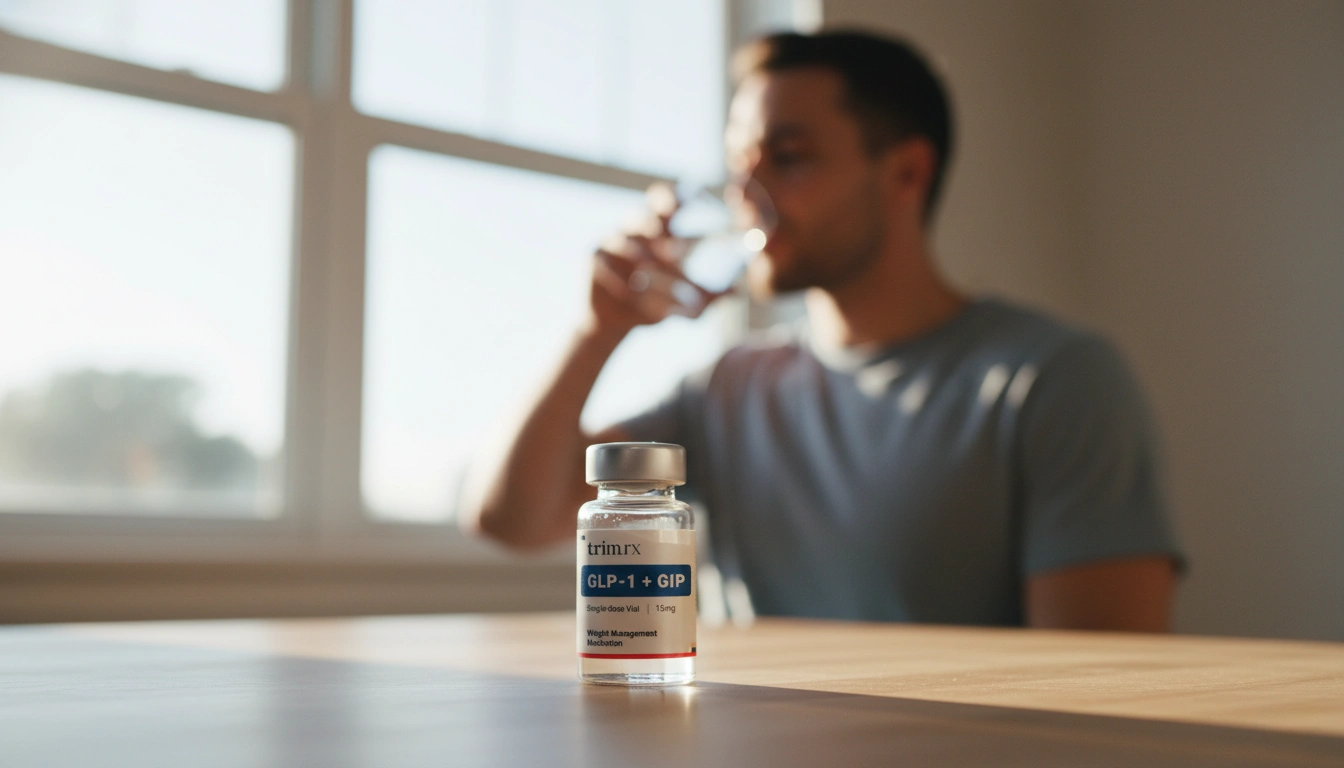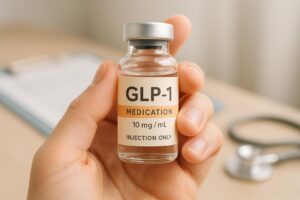How Many Calories to Eat on GLP-1: A Comprehensive Guide

Introduction
Have you ever felt overwhelmed by the sheer amount of information surrounding weight loss, especially when it comes to dietary needs while taking medications like GLP-1 agonists? You’re not alone. With the rise of GLP-1 medications such as Ozempic®, Wegovy®, and Mounjaro®, many individuals are seeking clarity on how to manage their nutrition effectively during their weight loss journey. In fact, studies indicate that as many as 1 in 8 adults have turned to these medications to support their weight loss goals, highlighting the growing popularity and necessity of understanding how these drugs interact with our dietary habits.
At TrimRx, we recognize that embarking on a weight loss journey can be daunting, especially when it comes to understanding the nutritional requirements that complement GLP-1 treatments. Our mission is to empower you with the knowledge needed to navigate this path safely and effectively. In this blog post, we will delve into the essential aspects of calorie intake while on GLP-1 medications, explore why tracking your caloric consumption is crucial, and provide practical strategies for maintaining a balanced and nutritious diet.
By the end of this article, you’ll have a comprehensive understanding of how many calories to eat while on GLP-1 medications, along with actionable tips to ensure you meet your nutritional needs without compromising your weight loss goals. We will also touch on the importance of personalized care and how our tailored programs at TrimRx can support you in your journey towards healthier living.
Understanding GLP-1 Medications
Before we dive into calorie counting, it’s essential to understand what GLP-1 medications are and how they function in the body. GLP-1, or glucagon-like peptide-1, is a hormone that plays a significant role in regulating appetite and glucose metabolism. GLP-1 medications work by mimicking this natural hormone, leading to several effects:
- Appetite Regulation: GLP-1 medications help reduce appetite, making you feel fuller for longer.
- Slowed Gastric Emptying: They delay the process of food leaving the stomach, which contributes to prolonged feelings of satiety.
- Improved Insulin Sensitivity: These drugs enhance the body’s response to insulin, helping to stabilize blood sugar levels.
With these mechanisms in play, individuals using GLP-1 medications often experience significant weight loss. However, the changes in appetite and satiety can also make it challenging to meet daily nutritional needs, which brings us to the critical question of caloric intake.
How Many Calories Should You Eat on GLP-1?
Determining the right amount of calories to consume while taking GLP-1 medications largely depends on individual factors such as age, gender, activity level, and overall health goals. However, general guidelines can provide a useful starting point.
General Caloric Recommendations
- Women: Generally, women on GLP-1 medications should aim for a caloric intake of 1,200 to 1,500 calories per day.
- Men: For men, the recommendation typically falls between 1,500 and 1,800 calories per day.
These ranges are based on studies suggesting that these caloric levels can promote weight loss while ensuring that individuals meet their essential nutritional needs. It’s important to note that these figures can be adjusted based on personal activity levels and metabolic factors. For instance, more active individuals may require a higher caloric intake to sustain their energy levels.
Individualized Caloric Needs
At TrimRx, we emphasize the importance of personalized care. We encourage anyone considering GLP-1 medications to take our free assessment quiz to determine their eligibility for our personalized weight loss programs. This quiz helps us tailor a treatment plan that aligns with your unique needs and lifestyle, ensuring you receive the most effective support.
Take our free assessment quiz here!
Why Tracking Calories Matters
Tracking your caloric intake while on GLP-1 medications is crucial for several reasons:
-
Preventing Nutrient Deficiencies: As appetite decreases, it becomes easy to inadvertently underconsume essential nutrients. Regularly tracking calories helps ensure you’re eating enough to meet your body’s needs.
-
Understanding Body Signals: Keeping a log of what you eat can enhance your awareness of hunger cues and help you identify patterns related to your appetite and energy levels.
-
Managing Medication Side Effects: Some individuals may experience gastrointestinal side effects from GLP-1 medications, such as nausea or constipation. Understanding your caloric intake can help you make adjustments to your diet that mitigate these effects.
How to Track Calories Effectively
Tracking calories doesn’t have to be tedious. Here are a few strategies to make it easier:
- Use a Mobile App: Applications like MyFitnessPal or Lose It! can simplify the process of logging meals and tracking caloric intake. These apps often have extensive food databases and can calculate the nutritional content of your meals automatically.
- Keep a Food Diary: If you prefer a more traditional approach, jotting down your meals in a notebook can be beneficial. This method allows for reflection and helps you become more mindful of your eating habits.
- Portion Control: Understanding portion sizes is key. Using measuring cups or a food scale can help you accurately track your intake.
Nutritional Focus: What to Eat on a GLP-1 Diet
While calorie counting is essential, it’s equally important to focus on the quality of the calories you consume. Here are key nutritional components to consider:
Prioritize Protein
Protein is vital for preserving muscle mass, especially during weight loss. Individuals on GLP-1 medications should aim for a minimum of 60 to 70 grams of protein daily. Excellent sources of protein include:
- Lean meats (chicken, turkey)
- Fish and seafood
- Eggs
- Low-fat dairy products (Greek yogurt, cottage cheese)
- Plant-based options (tofu, tempeh, legumes)
Incorporate Healthy Fats
Healthy fats are important for overall health but should be consumed mindfully. They can help keep you satiated without causing rapid spikes in blood sugar. Opt for:
- Avocados
- Nuts and seeds
- Olive oil
- Fatty fish (salmon, mackerel)
Emphasize Fiber
Fiber is essential for digestive health and can enhance feelings of fullness. Aim for at least 25 grams of fiber daily. Incorporate foods such as:
- Fruits (berries, apples, pears)
- Vegetables (broccoli, carrots, leafy greens)
- Whole grains (quinoa, brown rice, whole-grain bread)
- Legumes (beans, lentils)
Stay Hydrated
Hydration is critical, especially since GLP-1 medications can reduce thirst. Aim for 2 to 3 liters of fluids per day, primarily focusing on water. Adequate hydration supports overall bodily functions and can aid in weight loss, as drinking water before meals may help control appetite.
Meal Planning Strategies
Creating a meal plan can simplify your dietary efforts while on GLP-1 medications. Here are some strategies to consider:
-
Plan Ahead: Dedicate time each week to plan your meals and snacks. This can help you make healthier choices and avoid the temptation of less nutritious options.
-
Batch Cooking: Preparing meals in advance can save time and ensure you have nutritious options readily available.
-
Portion Your Meals: Consider dividing meals into smaller portions to avoid overeating. Eating smaller meals throughout the day can help manage hunger and make it easier to meet your caloric needs.
-
Focus on Nutrient Density: Choose foods that provide a high amount of nutrients relative to their caloric content. This can help you stay within your calorie goals while ensuring you receive essential vitamins and minerals.
The Role of Professional Support
Navigating dietary changes while on GLP-1 medications can be complex. That’s why we at TrimRx advocate for the importance of professional guidance. Working with a registered dietitian can provide you with tailored meal plans, nutritional education, and ongoing support to help you achieve your weight loss goals effectively.
If you’re interested in personalized weight loss solutions, consider reaching out to our team to explore how we can assist you in your journey.
Explore our personalized weight loss programs today!
Conclusion
Understanding how many calories to eat while taking GLP-1 medications is an essential component of a successful weight loss journey. By focusing on a balanced intake of nutrients, tracking your caloric consumption, and seeking professional guidance, you can optimize your weight loss results while maintaining your health.
As you embark on this journey, remember that your path is unique. At TrimRx, we’re here to support you every step of the way with personalized care and innovative solutions designed to foster sustainable weight loss. If you’re ready to take the next step, we invite you to take our free assessment quiz to discover how our programs can help you achieve your health goals.
Take our free assessment quiz here!
FAQ
What are GLP-1 medications and how do they work?
GLP-1 medications are designed to mimic the hormone GLP-1, which regulates appetite and glucose metabolism. They help reduce appetite, slow gastric emptying, and improve insulin sensitivity, contributing to weight loss.
How many calories should I consume while on GLP-1 medications?
Generally, women should aim for 1,200 to 1,500 calories per day, while men should target 1,500 to 1,800 calories. Individual needs may vary based on factors like age, activity level, and specific health goals.
Why is tracking calories important?
Tracking calories helps prevent nutrient deficiencies, enhances awareness of eating habits, and allows for better management of potential medication side effects.
What should I focus on in my diet while on GLP-1 medications?
Prioritize protein, healthy fats, and fiber-rich foods while staying hydrated. A balanced diet will support your nutritional needs and weight loss goals.
Can I get professional help with my weight loss journey?
Absolutely! At TrimRx, we offer personalized weight loss programs and support from registered dietitians to help you navigate your journey effectively.

Transforming Lives, One Step at a Time
Keep reading
Tracking Progress With GLP-1: What To Measure
Learn which metrics to track on GLP‑1 therapy—weight, waist, blood sugar, lipids, side effects, and non‑scale wins—and how often to monitor them.
Fatigue Solutions for Ozempic and Wegovy Users
Hydration, protein-rich meals, light activity, and better sleep can reduce medication-related fatigue and help maintain energy during weight-loss treatment.
GLP-1 Medication Side Effect Checker
Worried about GLP-1 medication side effects? Use our free checker for Semaglutide, Liraglutide, and more to learn what to expect and stay informed!



